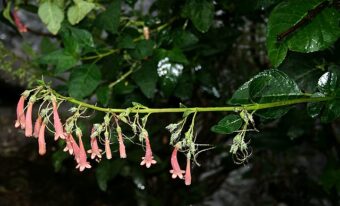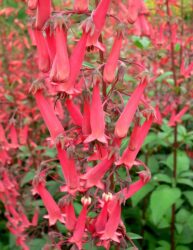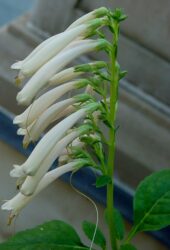In this article, we will discuss how to grow the prolific flowering shrub of Phygelius in containers. Phygelius, which has the common name of Cape Fuchsia or Cape Figwort, is a flowering shrub of two species that belong to the Scrophulariaceae (the Figwort) family. As the common name implies it comes from South Africa, where it grows on wet slopes and banks.

Although it is an evergreen shrub it cannot take frosts, but this should not put you off if you treat it as a border perennial by cutting off all stems in spring and allowing new ones to grow up from the base. Alternatively, if you can shelter it and place it against a south-facing wall, it should do well. You can trim frost bitten side-shoots from the main stem each year.
The lance-shaped green leaves are plain and not worth noting, but the long flowering period and the long tubular blooms are. The flowers come in a vast array of colours from white, pale yellow, orange, pink and even red. The similarity of the flowers to Fuchsia has led to its common name of Cape Fuchsia. However, they are not even closely related to each other.
Find out how to grow Phygelius in containers in this article.
GROWING PHYGELIUS IN CONTAINERS
First, you will need to choose a large enough container that will suit the plant in question and will be well-balanced. Whatever you choose make sure it has plenty of drainage holes at the bottom. Add a 2cm layer of gravel to aid drainage even further to this container.
On top of this add up to 5cm of the top rim with a good quality multipurpose compost. Dig a hole at the centre of the container slightly bigger than the root ball it came in the original container you bought the shrub in. Place the plant in so that the top of the root ball is at the same level as the top surface of the compost in the container. Backfill with the growing media so that no vacant spaces remain, using more compost if you find it necessary. Water it well after you have firmed it in. After you have planted and watered, you can cover the surface of the compost in the pot with a mulch made out of bark chippings or stones.
THE BEST GROWING CONDITIONS
You will need to place your Phygelius in a container in a place where it is protected from cold winds and harsh frosts-a South-facing wall is ideal. It does not necessarily need full sun as it thrives in partial shade as well.
You will need to water well until it is well-established, which means watering when the surface feels dry to the touch. After that, you will need to water when 5cm below the top surface of the compost feels dry to the touch.

It is recommended that every spring you give an annual dressing of a slow-release, general-purpose fertilizer to give enough nutrients to last through the growing season. You will not need to feed again during the growing season.
Pruning is relatively simple all you need to do is either prune all stems to ground level in April if you live in a cold area or if you live in a mild area, all you need to do is cut off all frosts bitten side shoots. Saying that, most Phygelius will benefit from pruning hard as they do not perform well in the second year. I would cut down to ground level every 2 years if you live in a mild area.
Propagation is via semi-ripe cuttings taken in summer and allowed to grow on in a cold frame.
PESTS AND DISEASES
In general, they are disease-free, although severe cold weather will destroy stems. This is easily treated by cutting to near the ground level in early spring any damaged stems.
In terms of pests, the Capsid bug can be a problem. The problem should be superficial but if you need to treat them you can choose a suitable systemic insecticide. Follow any written instructions on when to spray to avoid killing beneficial insects.
VARIETIES TO GROW

The main species is Phygelius aequalis which is widely available. It grows up to 1m high and on one side flower heads of numerous yellow through pink or red blooms appear. A noted variety is the ‘Yellow Trumpet’ that produces all yellow flowers.
The other species is Phygelius capensis which has nodding flowers all around the spikes. A noted variety is ‘Coccineus’ which has yellow-throated red blooms that have a reflexed tube at the mouth.
A hybrid of the two species is Phygelius x rectus and several varieties are listed. This includes the dark pink ‘Devil’s Tears’, the even darker pink ‘Sensations’, the yellow ‘Moonriver’ and the salmon orange ‘Salmon Leaf’. Others include the orange flowering ‘Funfare Orange‘, the pink varieties ‘Pheegees Passionate Pink’ and ‘Funfare Wine’.
CONCLUSIONS
In this article, we have discussed how to grow the wonderful and prolific flowering shrub of Phygelius in containers. Although they may not be hardy and stems will die, new shoots will appear in spring before giving a beautiful flower show in summer.
They are easy to look after, easy to care for and relatively pests and diseases free and are in flower for such a long time.
Why not grow one today?
If you have any questions or comments that you wish to make on growing Phygelius in containers, please do so in the comment box below.
Happy Phygelius growing.
